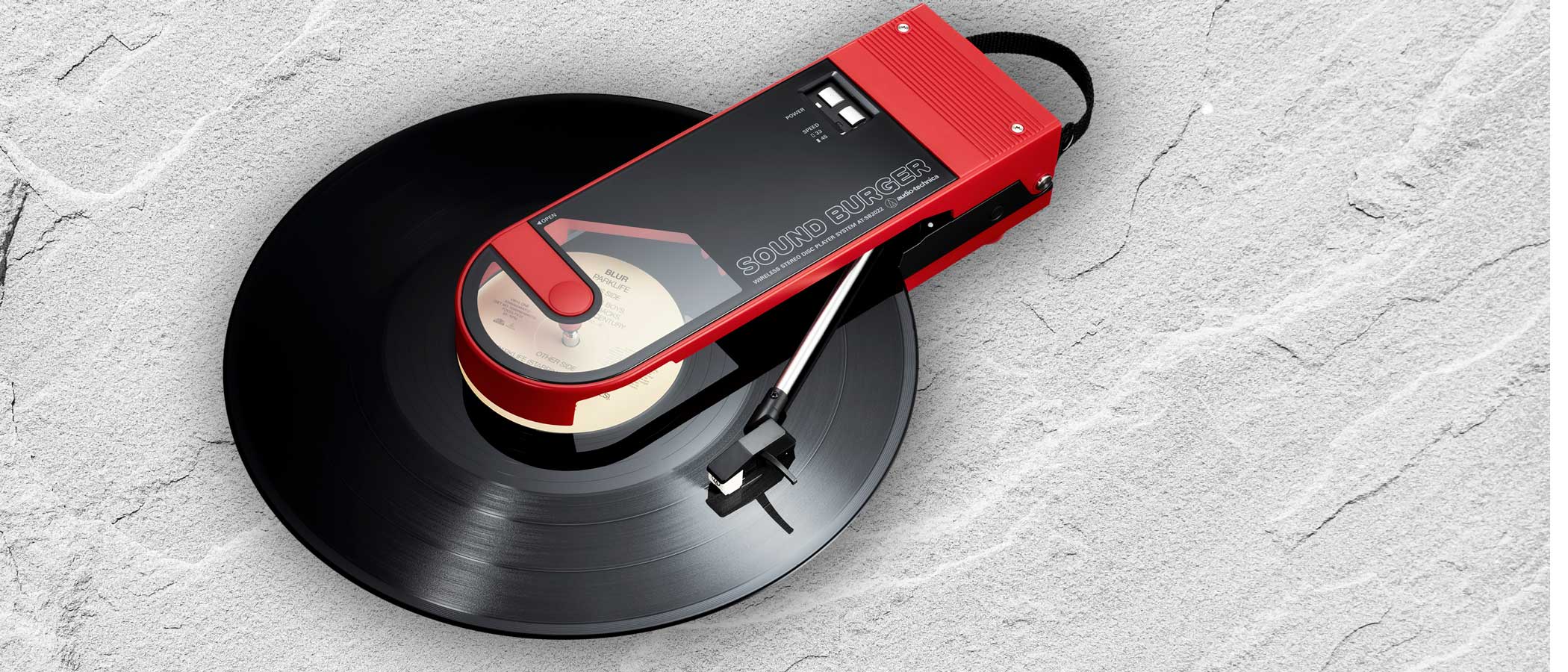What Hi-Fi? Verdict
Revived after 40 years to celebrate Audio-Technica’s 60th anniversary, the 2022 Sound Burger not only adds rechargeable battery operation and Bluetooth streaming, it proves that the Burger was no toy, but a competent turntable at the price.
Pros
- +
Instant appeal
- +
Sounds almost as good as a normal one
- +
Rechargeable battery
- +
Bluetooth and line outputs
Cons
- -
Some underlying noise
- -
They haven’t made enough…
- -
…so you almost certainly can’t get one
Why you can trust What Hi-Fi?
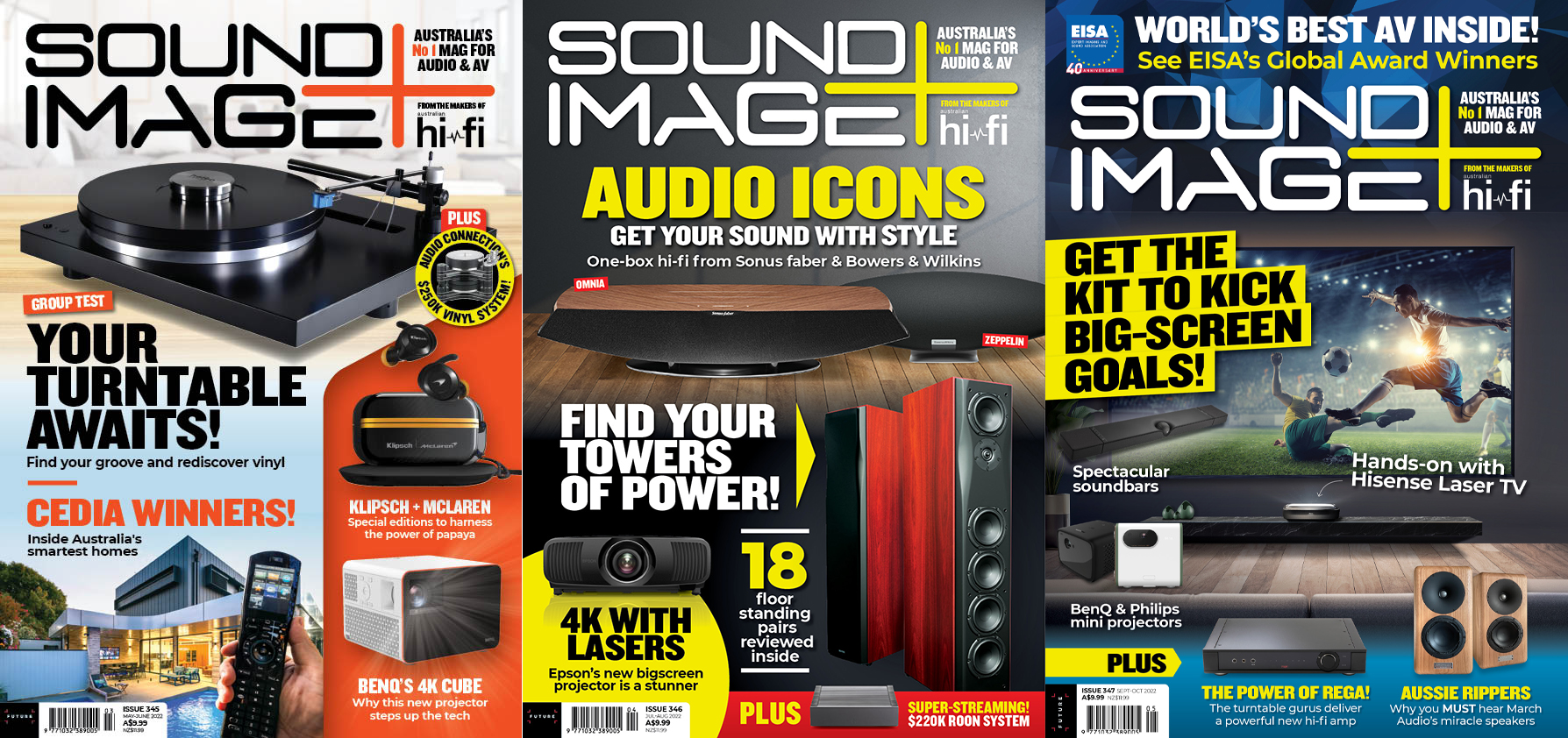
This review originally appeared in Sound+Image magazine, Australian sister publication to What Hi-Fi?. Click here for more information on Sound+Image, including digital editions and details on how you can subscribe.
Only six months ago, we wrote a little history of Audio-Technica, by way of celebration of the company’s 60th birthday in 2022. And as we passed through the information and memories of the 1980s, we were reminded of the time when the company came up with a bright red attempt at a portable battery-powered turntable, released in some markets as ‘Mister Disc’, but known to most of the world as the ‘Sound Burger’.
The Sound Burger could play both singles and albums, it came with a set of fold-up headphones, and was supported by some natty advertising. In our history we ended that section with the comment: “How much do we want a re-release of the Sound Burger!”
Those in the know at Audio-Technica must have chuckled. They were already working on a revival, and not just a replica, but an update. Ladies and gentlemen, please welcome a Sound Burger for the 21st century.
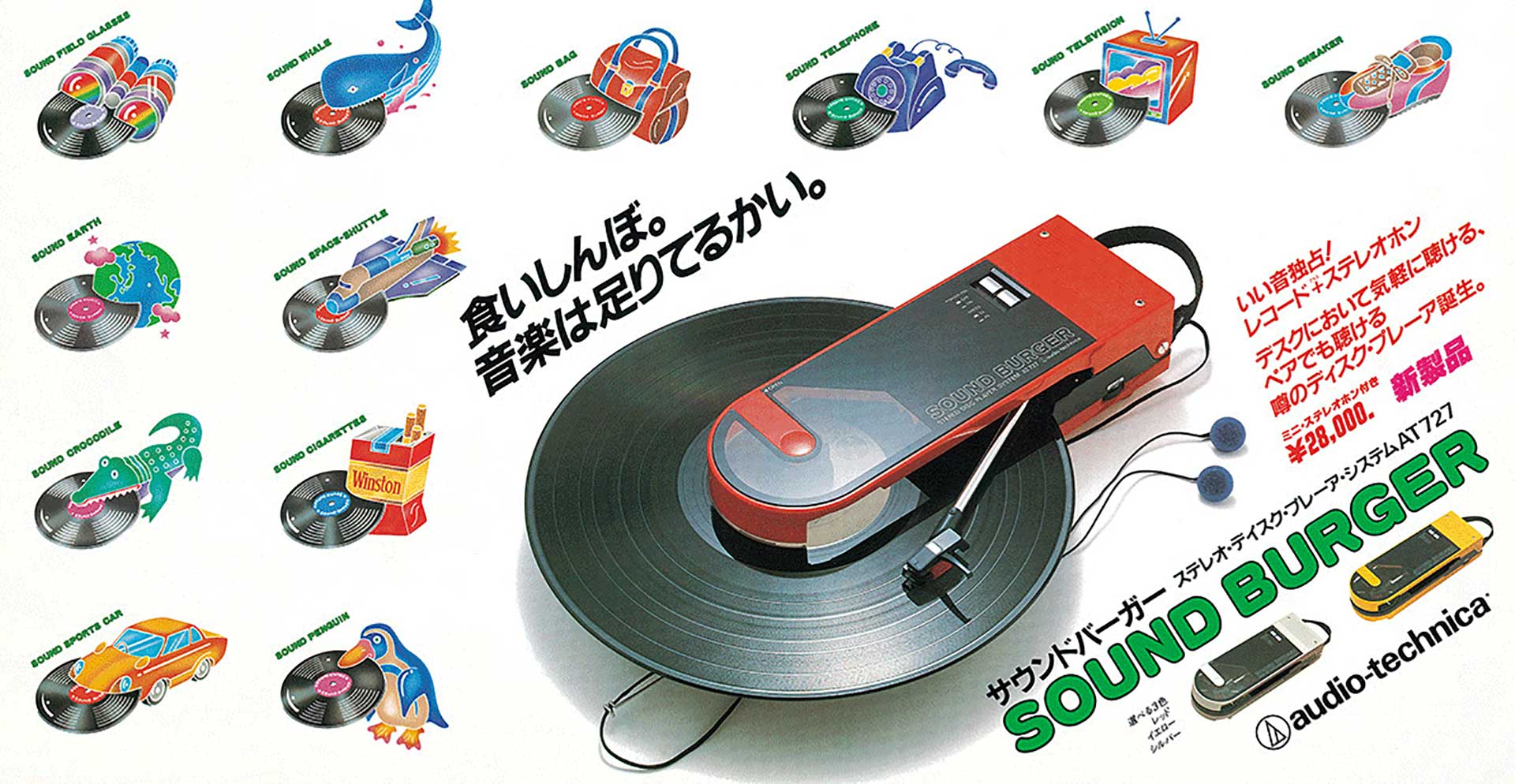
Sound Burger 1982
Compact Disc arrived in 1982, and to a company built on a thriving turntable cartridge business, it presented an existential threat. It took less than five years for silver discs to outsell vinyl for the first time, the beginning of what many believed would be the total demise of vinyl, and with it the end of any cartridge and tone-arm business for Audio-Technica.
The Japanese company had been riding high after 20 years dedicated to providing affordable cartridges that would bring high-fidelity music into more homes, an idea that had grown in the mind of founder Hideo Matsushita as he spent his thirties conducting ‘LP concerts’ at Tokyo’s artsy ‘Bridgestone Gallery’, where people would hear vinyl records played on high-quality audio equipment.
In 1962, with a capital of one million yen and three employees, he aimed to bring that experience to the home; he rented a one-storey private house in the Shinjuku district of Tokyo and began building the AT-1, a moving-magnet cartridge that claimed to “revolutionise sound quality” with a technology that implanted a diamond needle without crushing the tip of the pipe cantilever.
The AT-1 and its successors quickly became bestsellers, and were followed by innovations like the patented ‘VM’-type Dual Moving Magnet design, which duplicated the V-shaped structure of vinyl cutting heads and used two small magnets on the stylus cantilever to better track extended frequency response and channel separation.
By 1982 the company had released its first diamond cantilever and was perfecting a new secret weapon – single-crystal high-purity oxygen-free copper, known as PCOCC, used in both the coil wires and the terminals of the company’s new AT-OC9 cartridge.
But what could the future be for such cartridges in the new world of Compact Disc?
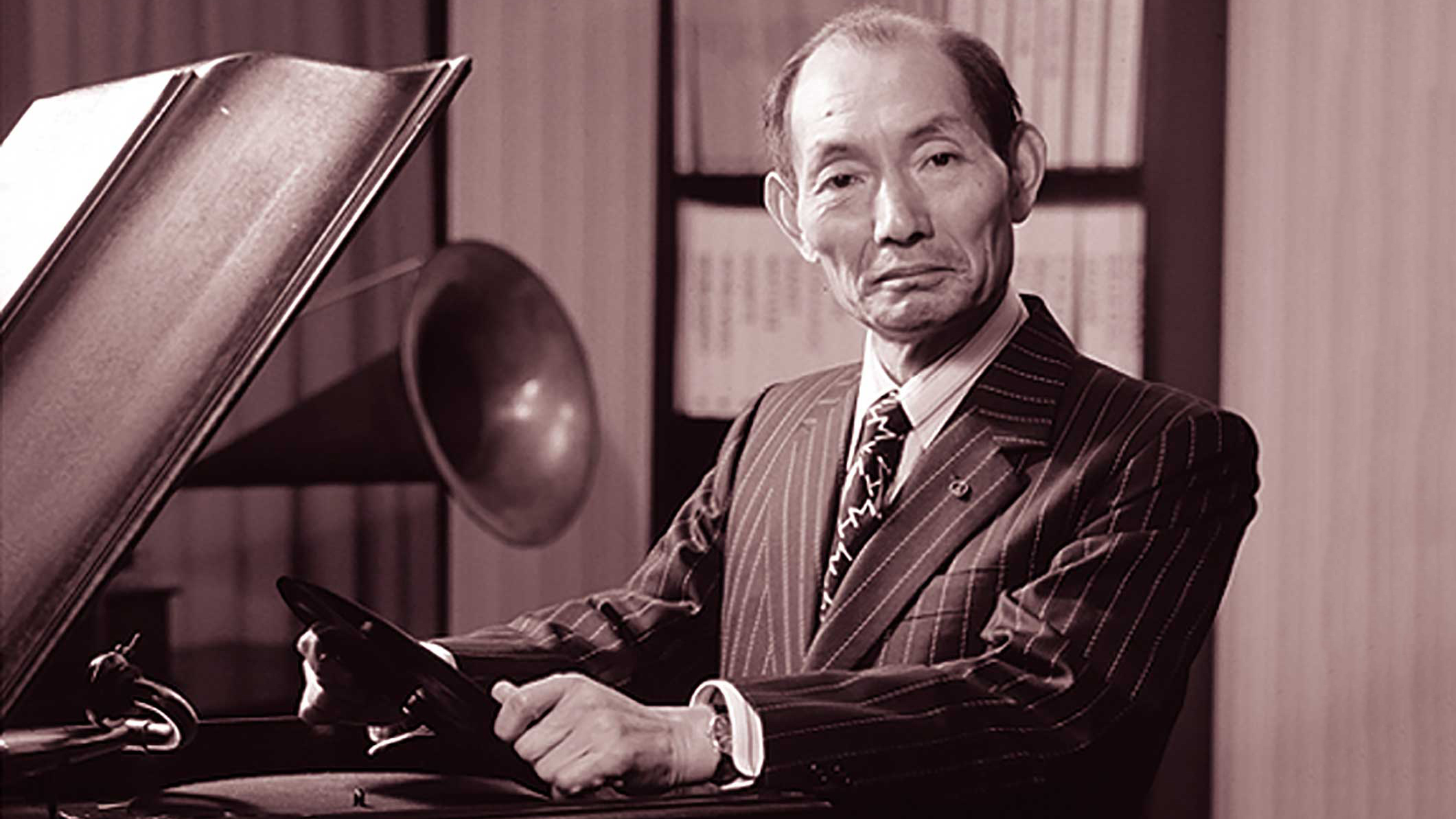
The company did initially pivot, conducting research and development into semiconductor lasers and optical pick-ups, and delivering actuators for both LaserDisc machines and CD players. But these would never bring the company the same large-scale replacement business as occurred with stylii and cartridges in the vinyl world.
Hideo Matsushita announced a challenge for his employees: to come up with “original ideas and technology" that could provide new direction for the company. One result of this was a little-known area of success for Audio-Technica: sushi-making machines. Today its subsidiary AUTECis number two in a 50-country market for sushi-makers.
At the same time, Sony’s cassette Walkman was riding high. Audio-Technica even released a ‘Point’ series of lightweight headphones designed for that market. It was still a couple of years until Sony’s CD Discman, but at Audio-Technica, someone had already suggested applying the same concept to vinyl replay. Could they make a portable turntable?
Yes they could: enter the original Sound Burger, a plastic clamshell with a pivoting arm and a small die-cast aluminium turntable onto which an LP or single could be affixed and spun under belt-drive by an electronically-controlled DC motor.
Underneath was a battery compartment for three ‘C’ sized batteries, and it came with a pair of spindly ATH-0.15F “stereophones”; two other ‘Point’ series stereophone models were also available separately, and two pairs could be attached to the Sound Burger at once, so you could listen with a friend. Of course that required a built-in phono stage to be included, and that also allowed the output to be plugged into any radio-cassette player or amplifier.
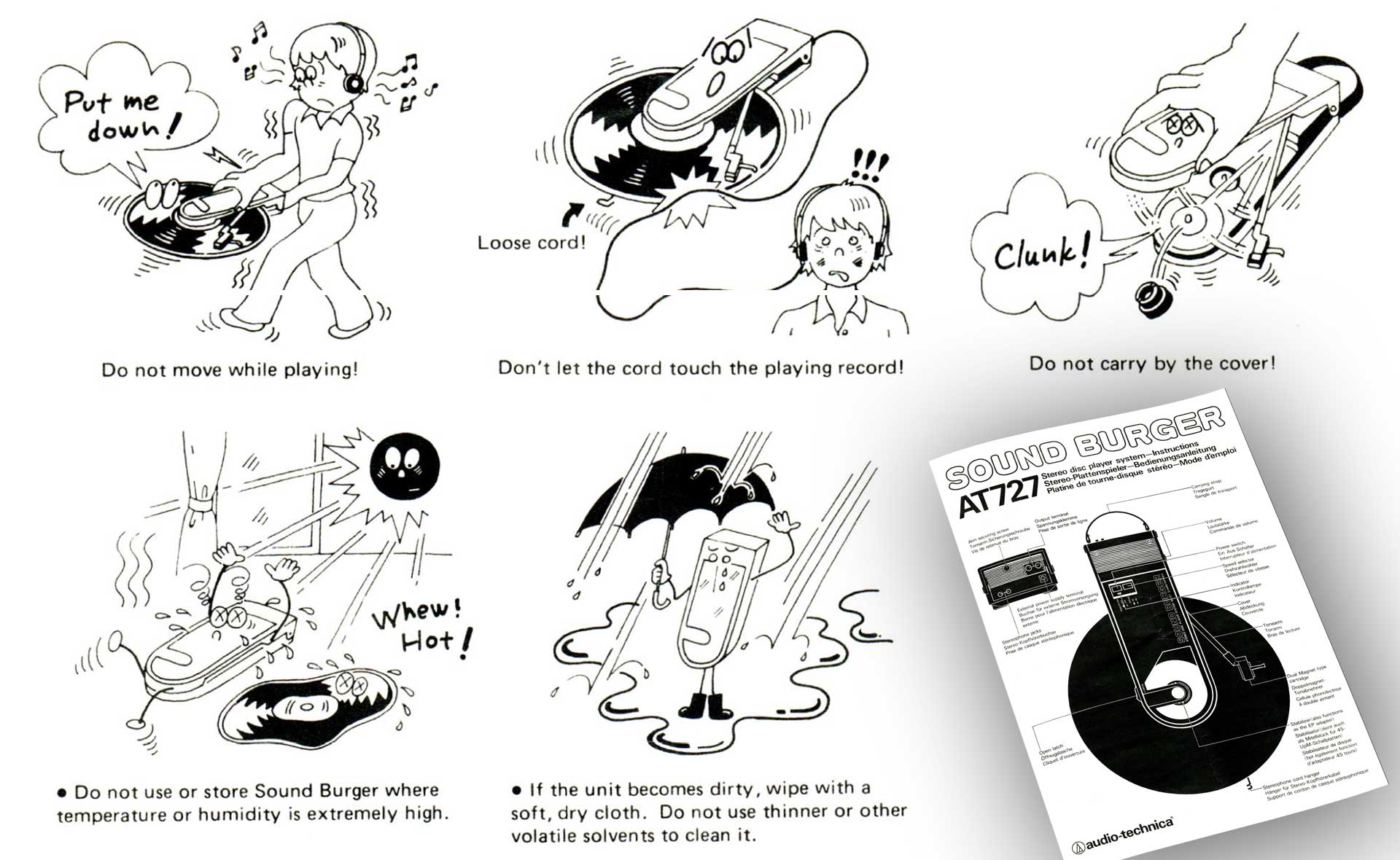
In some respects, a portable turntable clearly couldn’t compete with portable cassette or portable CD players.
“Do not move while playing!” is the first warning of several in the original manual of the AT727 Sound Burger, highlighting the most fundamental issue. Another obvious quandary is how much vinyl you might plan to carry with you.
As a result of this, and the Sound Burger’s appearance at the dawn of CD, this portable record player is often called “ill-fated”, or given a place in lists of “weirdest products”. Yet it was a popular product (Sony tried a similar concept in its far less excitingly designed linear-tracking PS-Q3 and siblings), and Sound Burgers have maintained a fan base over the decades since its disappearance. Vintage Mister Discs and Sound Burgers sell on eBay today for far more than the price of this new revived model; the service manual is still available (thanks to HiFi Engine among others), and there’s even a 3D-printing template available for a two-screw headshell to replace the one-screw version on the original, allowing owners to upgrade to modern cartridges.
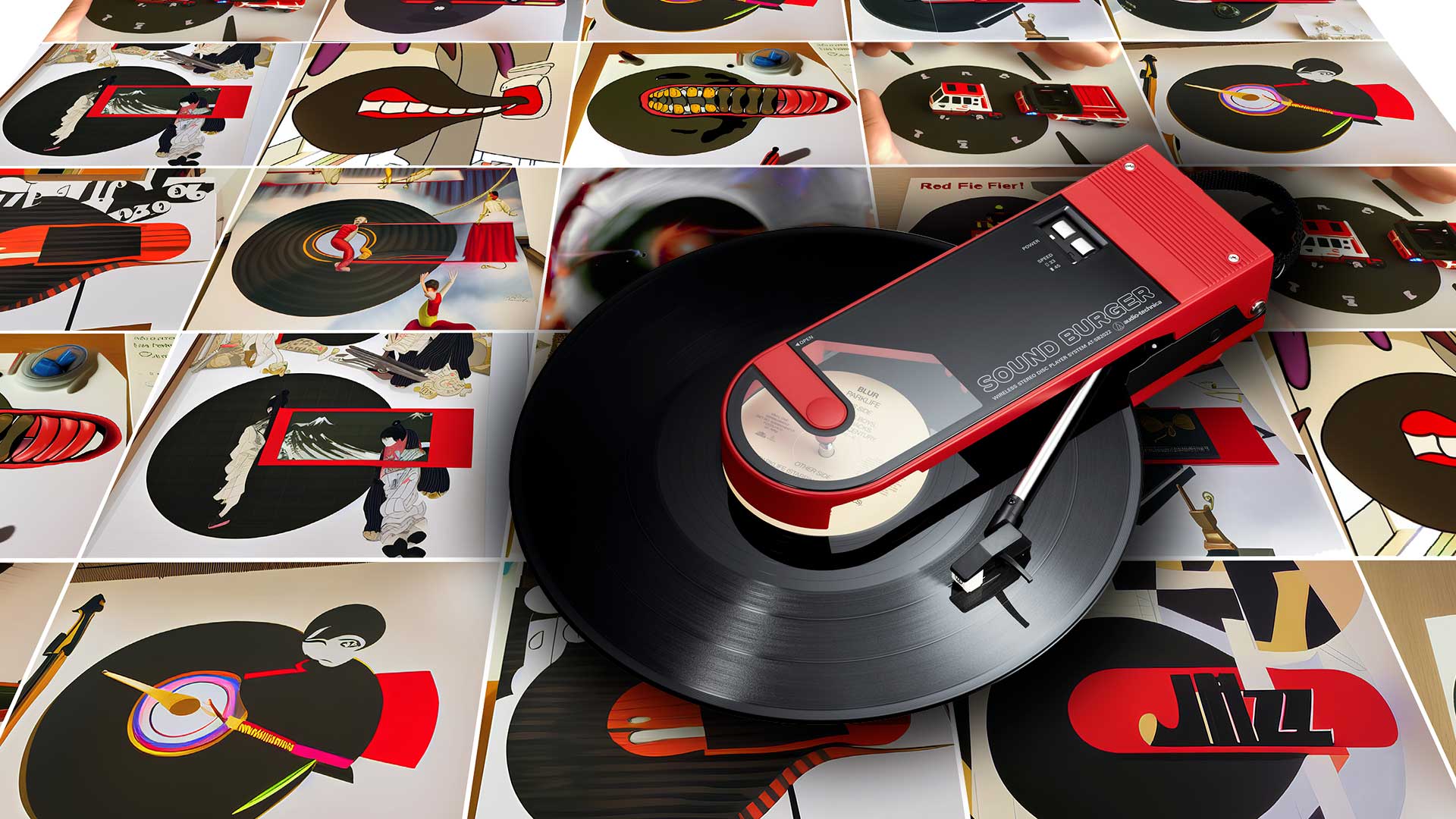
Sound Burger 2022
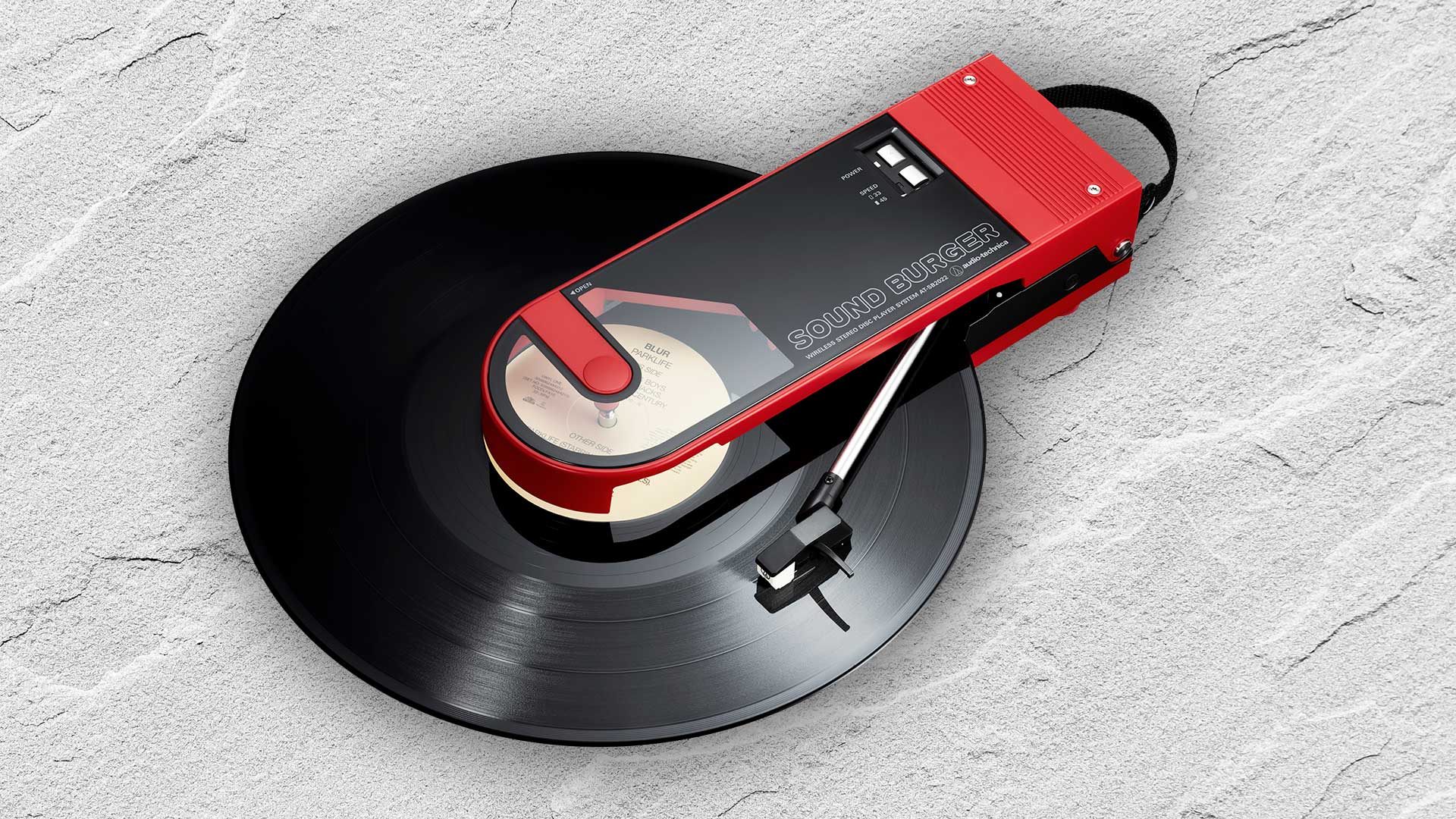
Type: belt-drive
Power: rechargeable 3.6V lithium-ion battery
Speeds: 33⅓, 45 rpm
Inputs: USB-C power
Outputs: minijack analogue, Bluetooth (SBC)
Charging time: 12 hours
Playback time: 12 hours
Dimensions (whd): 290 x 100 × 70 mm (empty)
Weight: 900g (empty)
Celebrating the company’s 60th anniversary, then, and 40 years since the original, Audio-Technica has released a new AT-SB2022 portable wireless disc player, the 21st-century update of the Sound Burger. In its wisdom, the company has made this a limited edition of 7000 numbered units, with only a few hundred allocated to Australia. We were first to get our hands on the single unit available here for demonstration and review.
You can guess the result – it’s sold out already. So we’re in the strange position of reviewing something you’re going to be very hard-pressed to get your hands on. We very much hope Audio-Technica relents, and restarts the production line for this thing of delight for those of us with a love of hi-fi. Because surely, in our time, with vinyl now declaring victory over those pesky CDs, the age of the Sound Burger has finally arrived.
We confess to being confused by the box it arrived in: a tall tasteful box that we thought might contain a bottle of wine, labelled in celebration of the 60th anniversary as it was, and its outer sheath made from a traditional Japanese paper called Echizen washi, from the original home prefecture of Hideo Matsushita and the city where Audio-Technica opened a new state-of-the-art Technica Fukui facility in 2010.
We even checked under this wine box to see if there was a turntable underneath, but no, the Sound Burger fits in this long thin box, and slides out easily, emerging along with further anniversary-celebrating paperwork, and accessories including an adapter for jukebox singles that have their centres punched out, a minijack-to-RCA audio cable, and a USB cable for charging, (supplied without a mains adaptor, keeping the product usefully international!).
All 7000 of the new Sound Burgers are red, and quite right too in our opinion! Much of the tech is retained, so this is still a belt-drive system driven by a high-precision DC motor, spinning an aluminium platter at either 33⅓ or 45 rpm.
The tonearm has a transport screw fixing it in place, and this long plastic screw needs removing from the far right end of the unit in order to swing the tonearm out into place, where it clunks into a notch at its outermost position. It retains the same dynamic balance system in which stylus pressure of approximately two grams is applied via a spring.
But this is not a replica: the AT-SB2022 has been brought into the 21st century. Instead of dual headphone outputs and RCA plugs, there are no headphone outputs here and just two sockets – one minijack audio output at line level for plugging into a system, and one USB-C socket for the cable to charge the player.
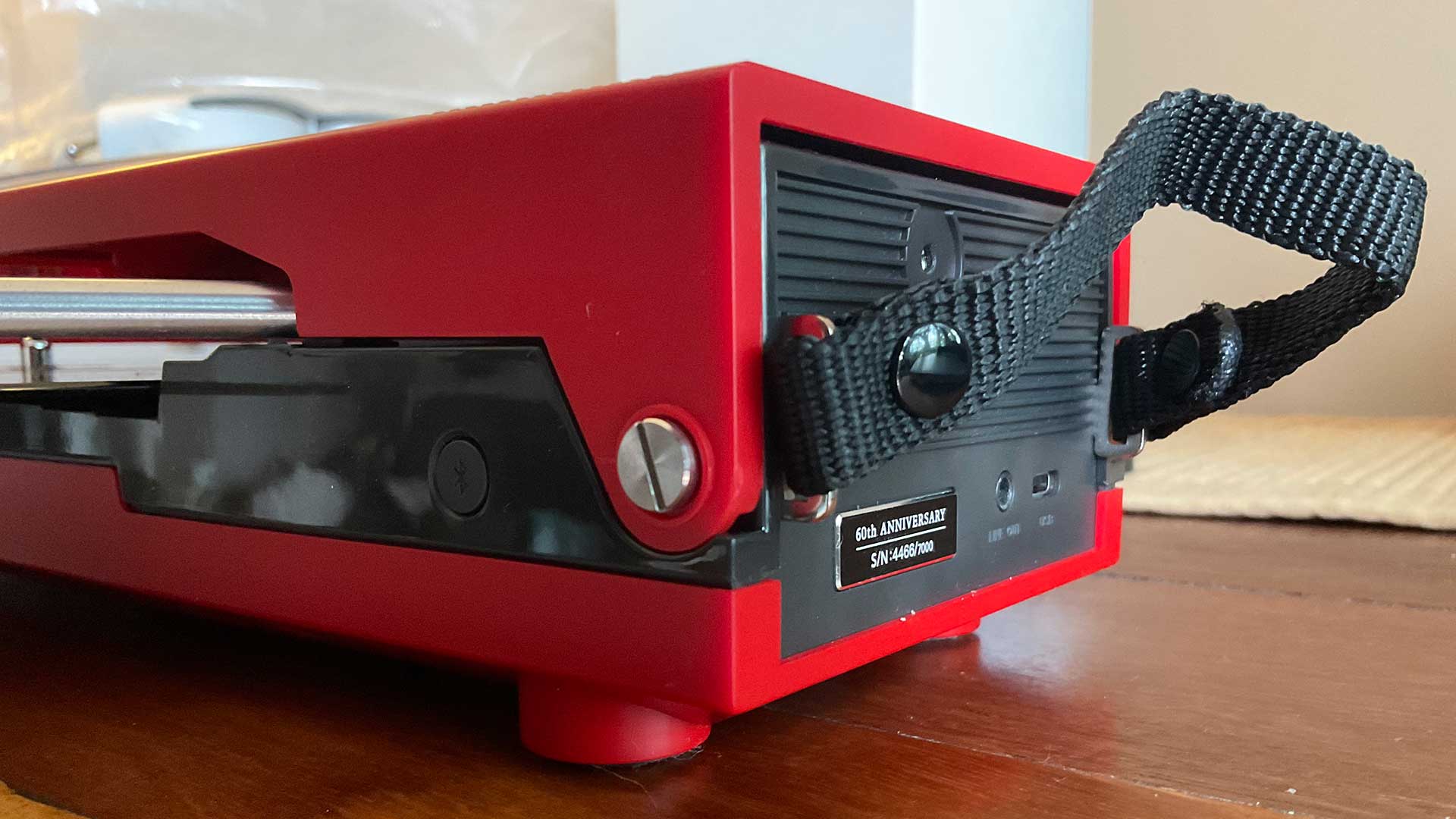
The USB-C socket marks a key change in terms of practicality – the Sound Burger no longer requires its three ‘C’-cell batteries, instead having a rechargeable lithium-ion battery. It takes 12 hours to charge, says Audio-Technica, and then gives some 12 hours of battery power. There seems no reason, however, that you couldn’t leave the USB cable plugged in at home, effectively running it on mains power.
The cartridge and stylus are modern versions of the ‘VM’-type dual moving magnet design, similar to but without the dual-screw mounting of the AT3600L cartridge, and we gather that ATN3600L replacement stylii (around $30) will fit just fine when you’re in need of replacement.
The other key addition is Bluetooth. Hold down the little black Bluetooth button at bottom right and the Sound Burger will look for any other devices in pairing mode: we soon had it linked with the Bowers & Wilkins Bond Px8 headphones (though of course Audio-Technica has some excellent BT headphones of its own, not least the Sound+Image award-winning ATH-M50xBT2), and found ourselves enjoying the strange experience of totally cable-free vinyl playback.
With the Sound Burger on batteries, and Bluetooth playback via headphones, there are neither signal nor mains cables – a vinyl miracle!
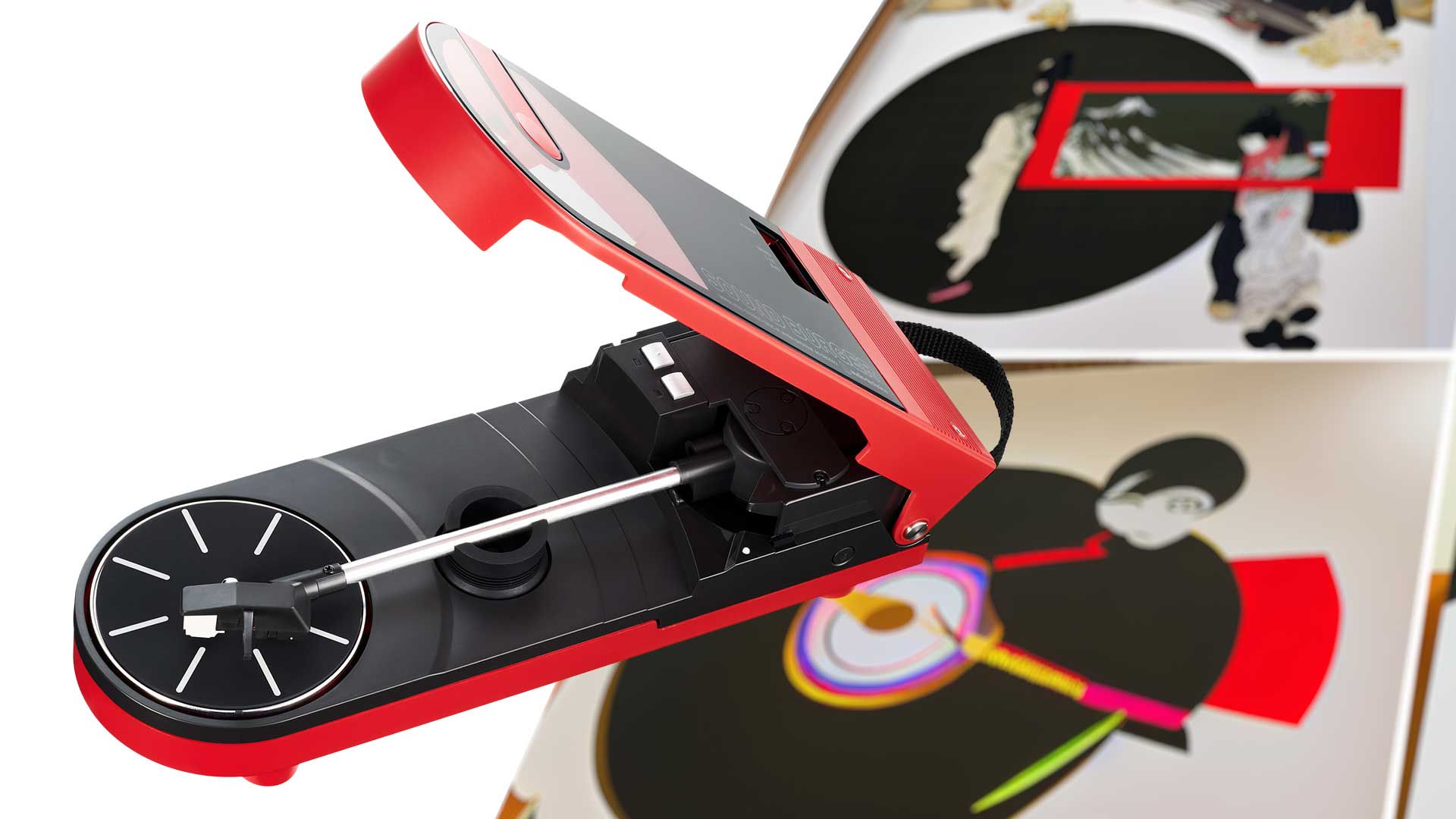
The one downside here is that the only Bluetooth codec supported here is the base-level SBC, with no AAC or aptX or anything else, so that the wireless sound quality will not be delivered at the best possible level.
Nevertheless we were immediately enjoying the sound. We had half-expected the kind of performance that emerges from extreme-budget record players – the Sound Burger was a novelty turntable, right?
We should have thought more highly of Audio-Technica. The Sound Burger actually does a very respectable job, though we were unable to use our usual app to make speed, wow and flutter measurements, because of the clamshell clamping shut over the spindle. The official specs quote wow and flutter at < 0.25% (WTD) at 3kHz, with signal to noise (via the analogue output) at > 50dB (DIN-B).
Compare that with, say, the comparably priced AT-LP60XBT, a conventional and also Bluetooth-equipped turntable from the same company, and you’d expect Sound Burger’s specs to be pretty average in comparison, right?
Nope – exactly the same numbers. So in terms of published specs, at least, the Sound Burger keeps up with Audio-Technica’s conventional turntables. This is not a toy.
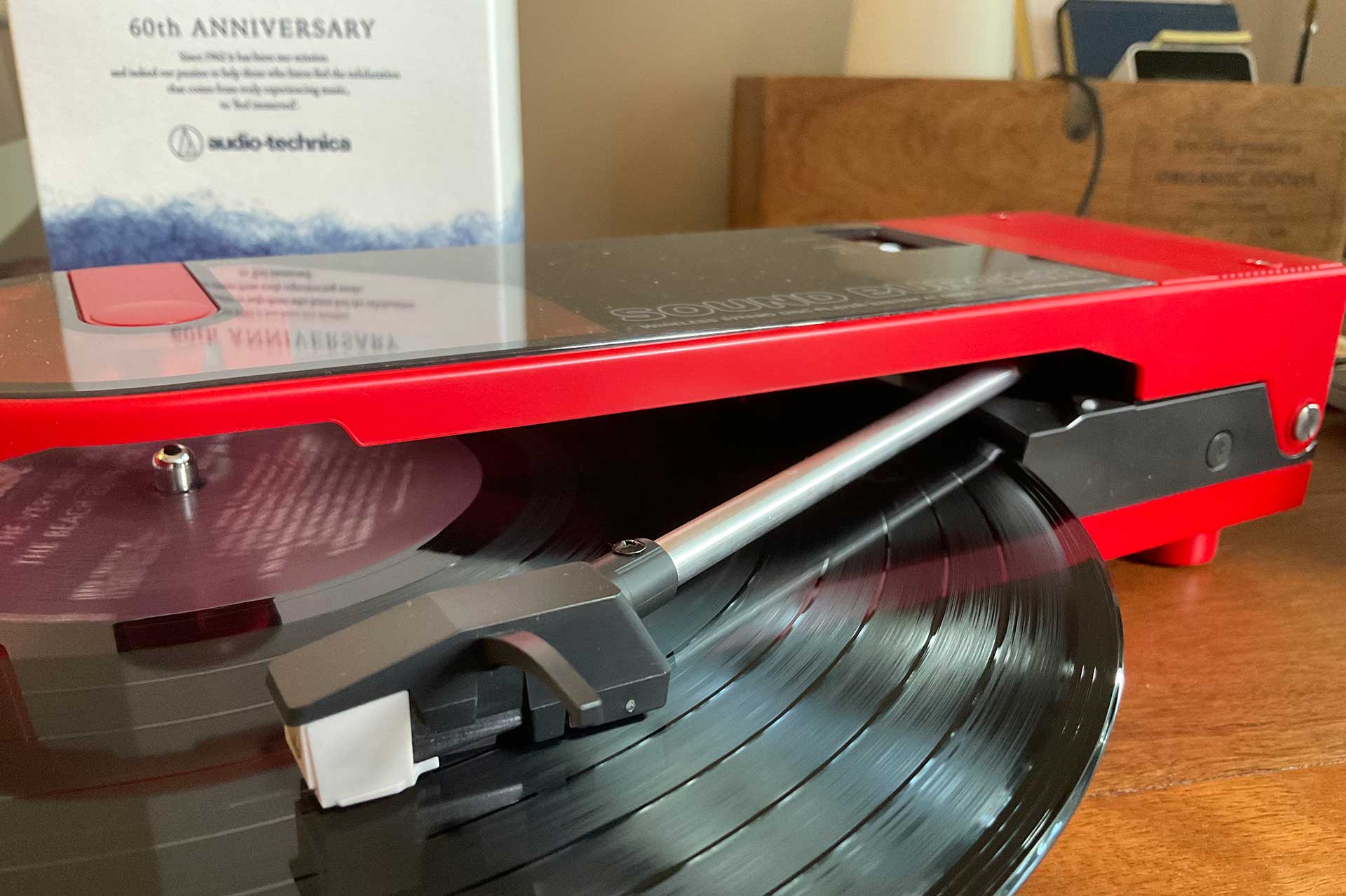
Listening sessions
We began on headphones while we were setting it up, but once everything was working we moved it to the music room, gave the Sound Burger the best possible support of a good Quadraspire hi-fi rack, and hard-wired its minijack output into our system.
Minijack is not the best hi-fi connection, of course, which might lead you to believe that the hi-fi credentials of a Sound Burger are limited.
You’d be wrong. We could hardly believe how well it compared with other turntables which have been through our system. When we played a simple acoustic piece, Pigs On The Wing pt2, last track on Pink Floyd’s ‘Animals’, it delivered nicely edgy and jangly panned guitars, with Roger’s vocal nicely clean and central. When we compared this with the same track played on the company’s AT-LPW40WN, a bare-bones deck at £320/$379/AU$699 deck, there was no great difference in tone or separation, just a better sense of stability from the conventional deck, with the soundstage from the Sound Burger occasionally sliding slightly to the left.
When Roger sings “So I… don’t feel alone, or the weight of the stone” there’s a sibilance on ‘So’ which was over-emphasised by both of these decks, but then we had to move up to something as high as Rega’s Planar 6 before we found a deck that didn’t do that.
When playing a quiet track like Flying Pt.1 from Keith Jarrett’s album ‘Changes’, there was also a very slight grinding rumble in the left channel in places, which even a budget deck like Sony’s PS-LX310BT avoids. There was also, despite the quoted specs, a little wowing audible on extended piano notes. But the actual shaping of the piano notes was better on the Burger than the Sony — brighter, and more alive, where the Sony felt damped down and controlled. The Burger did not, however, match the stability and silence of Sony’s pricier HX-500.
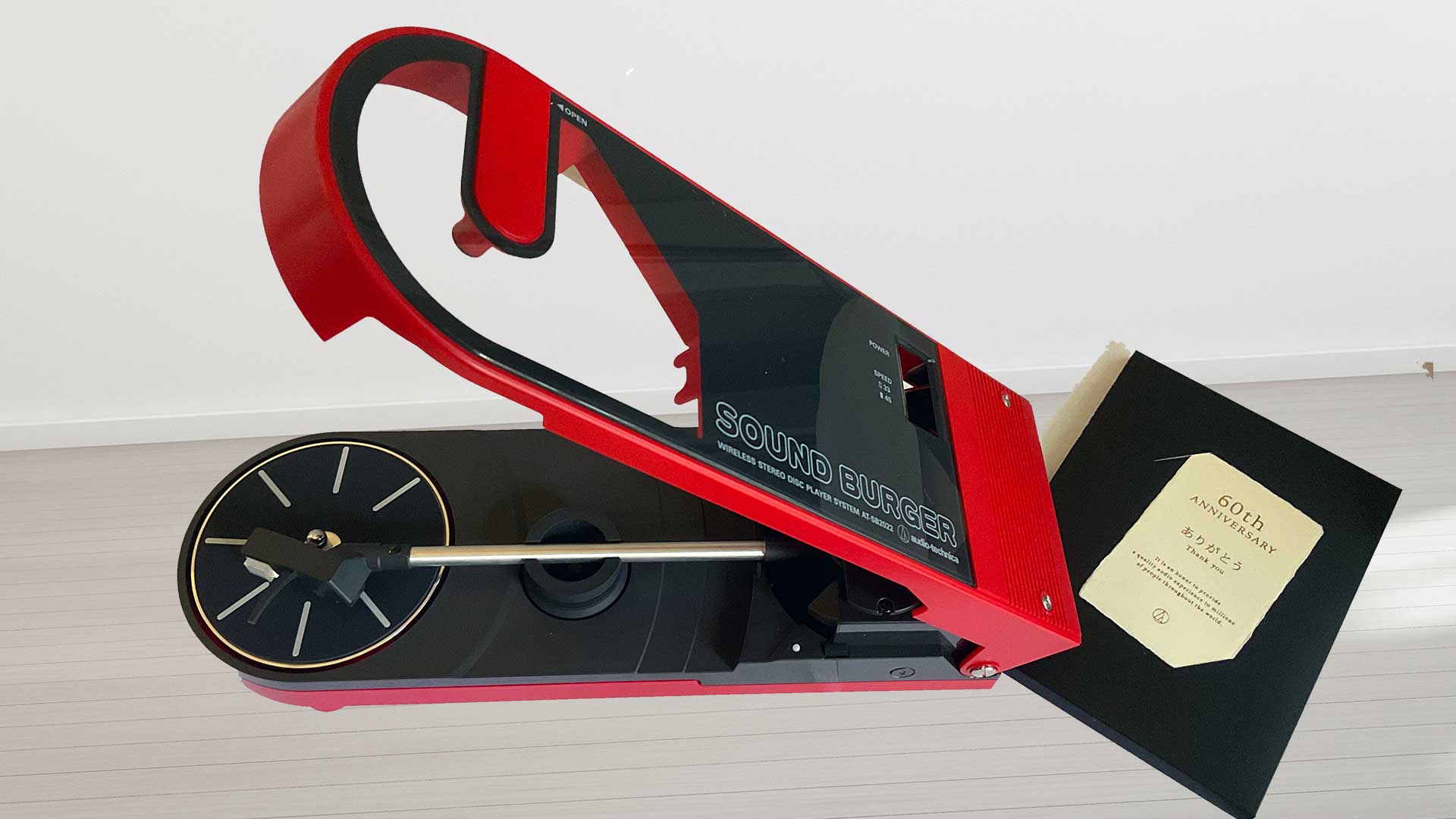
Complexity also had some limits, so that a dense piece of pop like Jeff Lynne’s The Sun Will Shine doesn’t fully burst forth at the break, and this – another track at the end of the side – also pulled a little to the left, sounding a little compressed, even grungy, compared to some of the cleaner-sounding decks, though rather similar to A-T’s own AT-LPW40WN.
So in performance terms, the Sound Burger surprised us by standing its own against price-comparable conventional decks, which we reckon is quite the achievement, given its nature. It’s not the ultimate turntable, of course, but then you wouldn’t expect that. And these comparisons were made by plugging its output into a very revealing system, beyond its price level.
Through lesser gear, or when Bluetoothed through headphones, the differences are less obvious, and the artefacts suppressed.
Yet even on the big gear it continued to entertain. We gave it our 1997 'EMI 100' pressing of ‘Band On The Run’, and it spread the title track wide and strong between the speakers, strong tom hits on the chorus, plenty of full bass content, and minimum of audible distortion, so that all in all there’s absolutely no way you’d guess this was coming from a portable battery-powered turntable. Sometimes we’d forget this ourselves, turn around and be surprised to see the outrigger tonearm wobbling slightly as it tracked the unsupported vinyl far out beyond the Burger’s edge.
There are a few operational cares to be taken, mind you, especially when moving the arm around. There’s no lever drop, so you’re in charge of lightly lowering the stylus into the groove and lifting it at the end, when it’s especially easy to make a mistake as there isn’t the usual height available; the arm is restricted by the Burger’s folding cover so you need to keep the arm low, but obviously not so low as to graze the vinyl surface.
The Bluetooth output will allow you to play into a Bluetooth speaker, or into Bluetooth headphones. If using a speaker we’d say you should still run the cable if you can. Our hi-fi amplifier also has Bluetooth, so we were able to compare the two outputs directly (or almost directly, since you have to pull the minijack cable out before the Bluetooth will work, and plugging it back in turns off Bluetooth). Performance via the cable definitely retains an edge on clarity over the slightly softened Bluetooth sound.
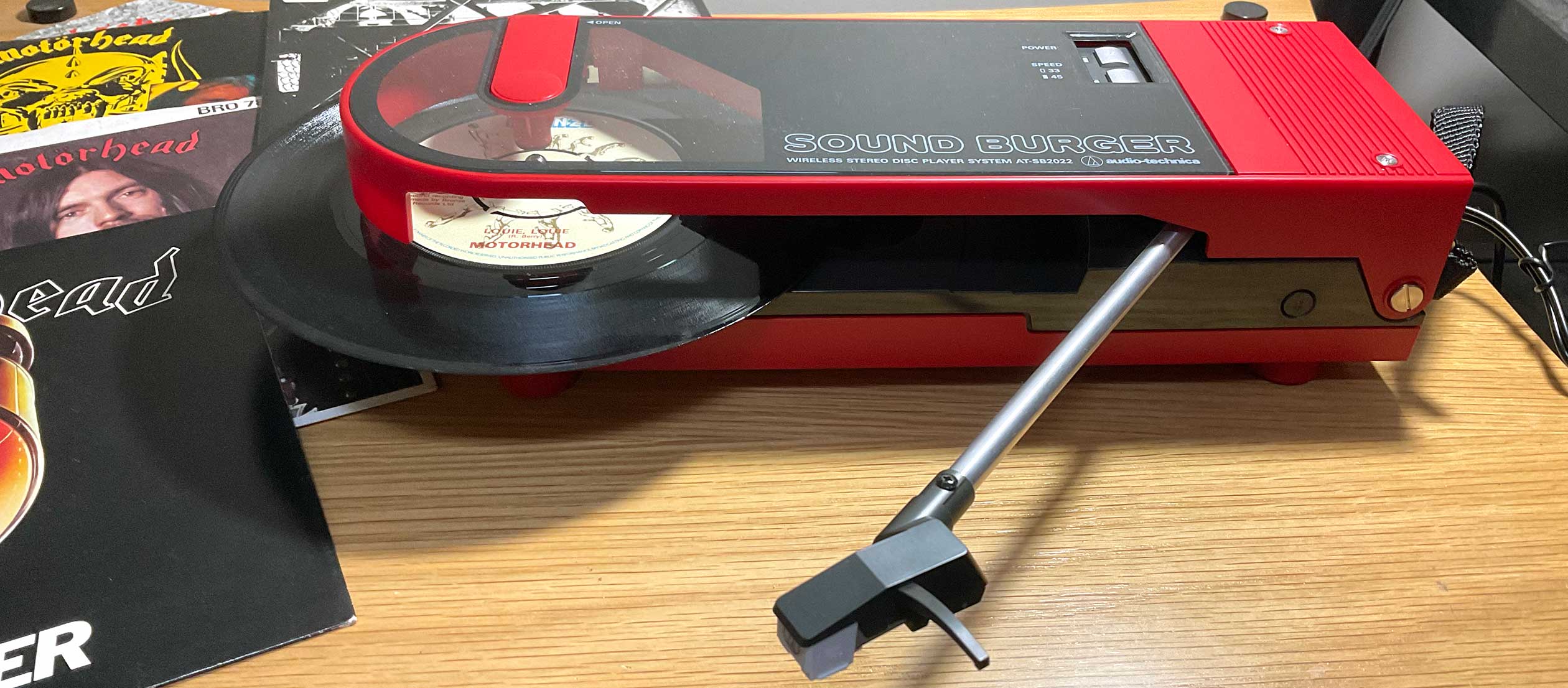
Not that you’ll notice on headphones. Vinyl listening with wireless headphones is a joy, as we’ve previously noted. Twenty minutes to roam the house enjoying a side of the black stuff, before returning to flip it or replace it.
Singles are a little less fun this way, but we do like the seven-inch format, and had a session at this higher rotational speed, which you select using the second of the two press-stud buttons; these have replaced the toggle switches on the original.
We grabbed a hands’ width of singles, happening on our Motorhead singles collection, so challenged the Sound Burger with Louie Louie, Bomber, and Over The Top. These singles could do with a clean, but the Burger chomped through them well enough, dynamics reduced by dirt, and of course we were popping the red top every three to four minutes. But the music powered through. (And we used a DS Audio ST-50 stylus cleaner between each play, to keep the playing interface pristine.)

Verdict
Obviously the Sound Burger is a desirable object in itself, but we can confirm that the performance is also up to speed for this price bracket, regardless of the unusual approach, and notably the lack of support under the outer edge of discs. We did find some mechanical noise, groove noise and occasionally stability issues more notable than we’d expect from a conventional deck. But otherwise the Burger matched its price peers note for note in terms of tone, soundstaging and musicality.
And here there’s Bluetooth and battery operation; the Bluetooth is a convenience thing, but battery power could even make a positive contribution in providing total isolation from the mains.
Should you take it to the beach? Well, if you get one, you can do what you like with it. Problem is – you almost certainly can’t have one. The Sound Burger 2022’s one gigantic problem is that they didn’t make enough of them. We gather not only the few hundred made available to Australia but pretty much the entire run of 7000 is likely to be accounted for.
So if you want one, join us in sending a message to Audio-Technica: make some more Sound Burgers please! After all, the originals came in many colours – so why not a rainbow of custom clam shells? This may have been a limited edition, but it can surely not take another 40 years for the next serving of Sound Burgers to arrive.
UPDATE: Our pleas have been heard! – along with many others, it seems. More Sound Burgers will arrive in 2023, sans individual numbering and anniversary packaging. More here, and watch this space...

Jez is the Editor of Sound+Image magazine, having inhabited that role since 2006, more or less a lustrum after departing his UK homeland to adopt an additional nationality under the more favourable climes and skies of Australia. Prior to his desertion he was Editor of the UK's Stuff magazine, and before that Editor of What Hi-Fi? magazine, and before that of the erstwhile Audiophile magazine and of Electronics Today International. He makes music as well as enjoying it, is alarmingly wedded to the notion that Led Zeppelin remains the highest point of rock'n'roll yet attained, though remains willing to assess modern pretenders. He lives in a modest shack on Sydney's Northern Beaches with his Canadian wife Deanna, a rescue greyhound called Jewels, and an assortment of changing wildlife under care. If you're seeking his articles by clicking this profile, you'll see far more of them by switching to the Australian version of WHF.
